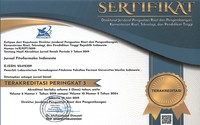Aktivitas Antijamur Ekstrak Etanol Daun Cengkodok (Melastoma malabathricum) Terhadap Pertumbuhan Malassezia furfur
Abstract
Keywords
Full Text:
PDF (Bahasa Indonesia)References
Aala F et al. (2014). Inhibitory effect of allicin and garlic extracts on growth of cultured hyphae. Iran J Basic Med Sci, 17(March):150–154. (https://www.ncbi.nlm.nih.gov/pmc/articles/PMC4016684/pdf/ijbms-17-150.pdf).
Aboubakr HA (2012). Tannase-producing fungi : isolation , screening , identification and optimizing the enzyme production, 1st ed. USA, LAP lambert academic publishing.
Alastruey et al. (2015). Susceptibility test for fungi: clinical and laboratorial correlations in medical mycology. Revista do Instituto de Medicina Tropical de São Paulo, 57(suppl 19):57–64.
Ali S et al. (2018). Phytochemical investigation and antimicrobial appraisal of Parrotiopsis jacquemontiana ( decne ) rehder. BMC Complementary and Alternative Medicine, 18(1):43.
Allen H, Goyal K, Ogrich L (2015). Biofilm formation by malassezia furfur/ovale as a possible mechanism of pathogenesis in tinea versicolor. Journal of Clinical & Experimental Dermatology Research, 06(06):1–4.
Altemimi A et al. (2017). Phytochemicals: extraction, isolation, and identification of bioactive compounds from plant extracts. Plants (Basel), 6(42):1–23.
Andriyawan F (2015). Uji aktivitas antibakteri ekstrak etanol daun cengkodok (melastoma malabathricum l.) terhadap escherichia coli secara in vitro. Jurnal Pendidikan Dokter Kalbar, 3(1):1.
Ansari MA et al. (2013). Natural phenolic compounds: a potential antifungal agent. Microbial pathogens and strategies for combating them: science, technology and education, (Table 1):1189–1195.
Ashbee HR (2007). Update on the genus malassezia. Medical Mycology, 45(4):287–303.
Auzia N, Lukmayani Y, Dasuki U (2017). Isolasi dan identifikasi senyawa metabolit sekunder ekstrak n-heksan dari umbi lobak (raphanus sativus lamk). Prosiding Farmasi, 2:285–293.
Balouiri M, Sadiki M, Ibnsouda SK (2016). Methods for in vitro evaluating antimicrobial activity : a review. Journal of Pharmaceutical Analysis, 6(2):71–79.
Bayot M, Bragg B (2019). Antimicrobial susceptibility testing. Florida, Treasure Island (FL): StatPearls Publishing (https://www.ncbi.nlm.nih.gov/books/NBK539714/).
Boekhout T et al. (2010). Malassezia and the skin: Science and clinical practice. Springer-Verlag Berlin Heidelberg.
Campestre C et al. (2017). Analysis of imidazoles and triazoles in biological samples after microextraction by packed sorbent. Journal of Enzyme Inhibition and Medicinal Chemistry, 32(1):1–11. (https://doi.org/10.1080/14756366.2017.1354858).
Cantón E, Pemán J (2009). Trends in antifungal susceptibility testing using CLSI reference and commercial methods. Expert Rev Anti Infect Ther:107–119.
Center of Disease Control and Prevention (2018). Antifungal resistance [web site]. (https://www.cdc.gov/fungal/antifungal-resistance.html, accessed 15 October 2019).
Christoper W, Diana N, Sari R (2017). Uji aktivitas antijamur ekstrak etanol umbi bawang dayak ( eleutherine americana ( aubl .) merr . ex k . heyne .) terhadap trichophyton mentagrophytes secara in vitro. Jurnal Kesehatan Andalas, 6(3):910–921.
Crespo EV, Florencio V (2006). Malassezia yeasts and pityriasis versicolor. Current opinion in infectious diseases, 19(2):139–147.
Departemen Kesehatan Republik Indonesia (2008). Farmakope herbal Indonesia. Jakarta.
Diana N, Sari R, Aisyah (2017). Uji aktivitas antijamur ekstrak etanol umbi bawang dayak (eleutherine americana (aubl.) merr. ex k. heyne) terhadap malassezia furfur secara in vitro. Jurnal Mahasiswa PSPD FK Universitas Tanjungpura, 5(1):3.
Gayen S, Ghosh U (2013). Purification and characterization of tannin acyl hydrolase produced by mixed solid state fermentation of wheat bran and marigold flower by penicillium notatum ncim 923. Biomed Res Int., 2013(1):1.
Gholib D (2009). Uji daya hambat daun senggani (melastoma malabathricum l.) terhadap trichophyton mentagrophytees dan candida albicans. Berita Biologi, 9(5):523.
Grosvenor PW, Suprinono A, Gray DO (1995). Medicinal plants from Riau Province, Sumatra, Indonesia-part 2: antibacterial and antifungal activity. Journal of Ethnopharmacology, 45(94):97–111.
Gupta A, Foley K (2015). Antifungal treatment for pityriasis versicolor. Journal of Fungi, 1(1):13–29.
Hasanah K (2017). Uji daya antifungi propolis terhadap candida albicans dan pityrosporum ovale. Bioedukasi, 10(2):44–46.
Hayati E et al. (2013). Identifikasi senyawa metabolit sekunder ekstrak n-heksana batang kesembukan (paederia foetida linn). Alchemy, 2(3):150–153.
Iatta R, Otranto D CCPMID (2017). The role of drug efflux pumps in malassezia pachydermatis and malassezia furfur defence against azoles. Mycoses, 60(3):178–82.
Jannata RH, Gunadi A, Ermawati T (2014). Daya antibakteri ekstrak kulit apel manalagi (malus sylvestris mill.) terhadap pertumbuhan streptococcus mutans. e-Journal Pustaka Kesehatan, 2(1):23–28.
Jenkins SG, Schuetz AN (2012). Current concepts in laboratory testing to guide antimicrobial therapy. Mayo Clin Proc, 87(3):290–308.
Joffry SM et al. (2012). Melastoma malabathricum (l.) smith ethnomedicinal uses, chemical constituents, and pharmacological properties: a review. Evidence-based Complementary and Alternative Medicine, 2012(Table 1):6–20.
Kaur S, Gupta S, Gautam PB (2019). Phytochemical analysis of eucalyptus leaves extract. Pharmacognosy and Phytochemistry, 8(January):2442–6.
Kaur T et al. (2017). Depigmented lesions of pityriasis versicolor: a diagnostic dilemma with review of literature. Our Dermatology Online, 8(2):207–209.
Lalitha S et al. (2016). Insignificant antifungal activity of plant extracts on malassezia furfur. Journal of Pharmaceutical Negative Results, 7(1):16.
Ledi R, Diana N, Mahyarudin (2018). Uji aktivitas antijamur ekstrak etanol eleutherine americana. merr. terhadap trichophyton tonsurans secara in vitro. Majalah Kedokteran Andalas, 41(1):22–31.
Li J et al. (2017). Antimicrobial activity and resistance : influencing factors. Front Pharmacol, 13(8):364.
Mahmoud Y, Metwally M, Mubarak H, Zewawy N (2015). Treatment of tinea versicolor caused by malassezia furfur with dill seed extract: an experimental study. International Journal of Pharmacy and Pharmaceutical Sciences, 7(2):1–7.
Marotta SM et al. (2016). Evaluation of the antibacterial activity of bergamot essential oils on different listeria monocytogenes strains. Ital J Food Saf, 5(4):6176.
Marselia S, Wibowo MA, Arreneuz S (2015). Aktivitas antibakteri ekstrak daun soma (ploiarium alternifolium melch) terhadap propionibacterium acnes. Jurnal Kimia Khatulistiwa, 4(4):1.
Muhammad N, Kamal M, Islam T, Islam N, Shafiquzzaman M (2009). A study to evaluate the efficacy and safety of oral fluconazole in the treatment of tinea versicolor. Mymensingh Med J, 18(1):31–5.
Muller F (2000). Azole cross-resistance to ketoconazole, fluconazole, itraconazole and voriconazole in clinical candida albicans isolates from hiv-infected children with oropharyngeal candidosis. Journal of Antimicrobial Chemotherapy, 46(2):338–341.
Naumann HD et al. (2017). The role of condensed tannins in ruminant animal production : advances, limitations and future directions. R Bras Zootec, 46(12):929–949.
Peano A et al. (2017). Methodological issues in antifungal susceptibility testing of malassezia pachydermatis. J Fungi (Basel)., 5(3):3.
Prasetyo MS, Entang I (2013). Pengelolaan budidaya tanaman obat-obatan (bahan simplisia). Bengkulu.
Prayitno H (2015). Uji aktivitas antifungal ekstrak metanol mentah rimpang jeringau merah (acorus calamus linn.) terhadap pertumbuhan malassezia furfur secara in vitro. Mahasiswa PSPD FK Universitas Tanjungpura, 3(1):3.
Puspadewi R, Adirestuti P, Menawati R (2013). Khasiat umbi bawang dayak (eleutherine palmifolia (l.) merr.) sebagai herbal antimikroba kulit. Kartika Jurnal Ilmiah Farmasi, 1(1):2.
Rina W, Guswandi HR (2014). Pengaruh cara pengeringan dengan oven, kering angin dan cahaya matahari langsung terhadap mutu simplisia herba sambiloto. Jurnal Farmasi Higea, 6(2):129.
Rojas FD et al. (2017). Antifungal susceptibility testing of Malassezia yeast: comparison of two different methodologies. Mycoses, 60(2):104–111.
Ronaa H et al. (2018). Comparison of effectiveness between celery juice (apium graveolens l.) and 2% miconazole towards the growth of malassezia furfur. Proceedings of the International Conference on Applied Science and Health, (3):73–77.
Sarbadhikary SB et al. (2015). Original Research Article Antimicrobial and Antioxidant Activity of leaf extracts of two indigenous angiosperm species of tripura. International Journal Of Current Microbiology And Applied Sciences, 4(8):643–655.
Schoffelmeer EAM et al. (1999). The cell wall of fusarium oxysporum. Fungal Genetics and Biology, 27(2–3):275–282.
Scorzoni L et al. (2017). Antifungal therapy: new advances in the understanding and treatment of mycosis. Frontiers in Microbiology, 8(1):1–23.
Shibata N et al. (2009). The cell wall galactomannan antigen from malassezia furfur and malassezia pachydermatis contains β-1,6-linked linear galactofuranosyl residues and its detection has diagnostic potential. Microbiology, 155(10):3420–3429.
Shukla N, Bhalodia R (2011). Antibacterial and antifungal activities from leaf extracts of cassia fistula l.: an ethnomedicinal plant. J Adv Pharm Technol Res, 2(2):104–9.
Singh M, Jha A, Kumar A (2014). Influence of the solvents on the extraction of major phenolic compounds ( punicalagin , ellagic acid and gallic acid ) and their antioxidant activities in pomegranate aril. J Food Sci Technol, 51(9):2070–2077.
Sreelakshmi S, Ajith V, Thankappan T (2018). Clinical and mycological study of pityriasis versicolor in relation to species. International Journal of Tropical Disease & Health, 31(1):1–6.
Stalhberger T et al. (2014). Chemical organization of the cell wall polysaccharide core of malassezia restricta. Journal of Biological Chemistry, 289(18):12647–12656.
Sutton S (2011). Determination of inoculum for microbiological testing. Journal of GXP Compliance, 15(3):49–53.
Uehling J, Deveau A, Paoletti M (2017). Do fungi have an innate immune response? an nlr-based comparison to plant and animal immune systems. PLoS Pathogens, 13(10):1–8.
Vandeputte P, Ferrari S, Coste AT (2012). Antifungal resistance and new strategies to control fungal infections. International Journal of Microbiology, 2012.
Vijayakumar R et al. (2006). Characterization of malassezia furfur and its control by using plant extracts. Indian J Dermatol, 51:145–8.
Yurayart C et al. (2013). Antifungal agent susceptibilities and interpretation of malassezia pachydermatis and Candida parapsilosis isolated from dogs with and without seborrheic. Med Mycol, 51(7):721–730.
DOI: https://doi.org/10.33096/jffi.v8i1.614
Copyright (c) 2021 Willy Sanjaya

This work is licensed under a Creative Commons Attribution-ShareAlike 4.0 International License.
Indexed by:
ISSN: 2356-0398 | e-ISSN: 2541-2329
Editor's Address:
Third Floor Pharmacognosy-phytochemistry laboratory building, Urip Sumoharjo road km. 5 Campus II UMI, Makassar, South Sulawesi, Indonesia
Phone: +6281524045514
Fax: +62411425619
E-mail: editorjfi@umi.ac.id

















.jpg)

